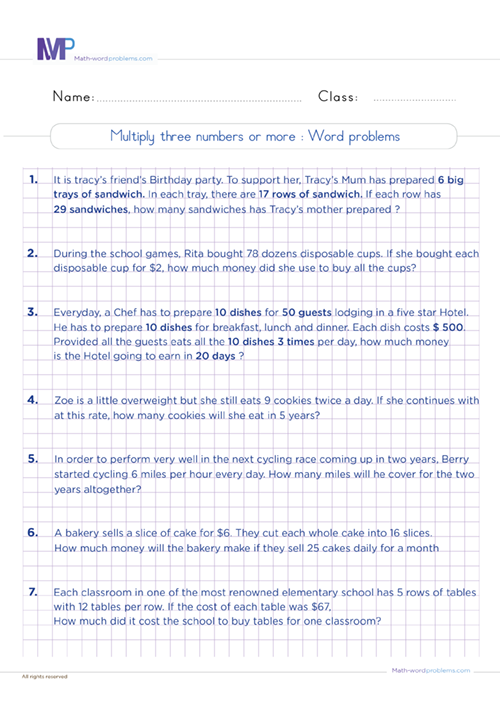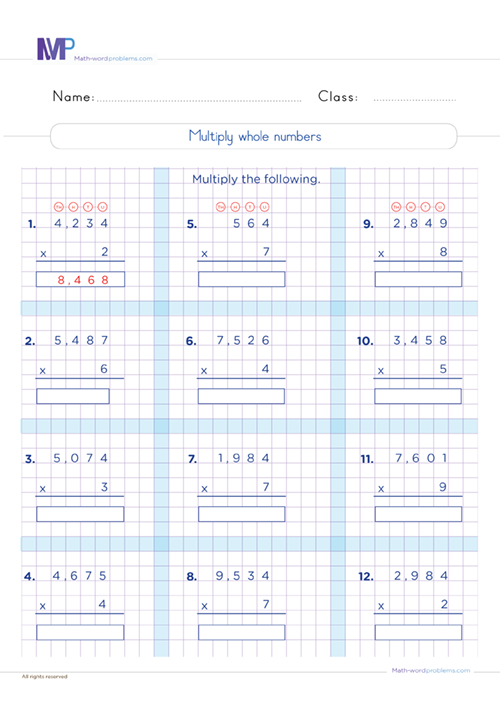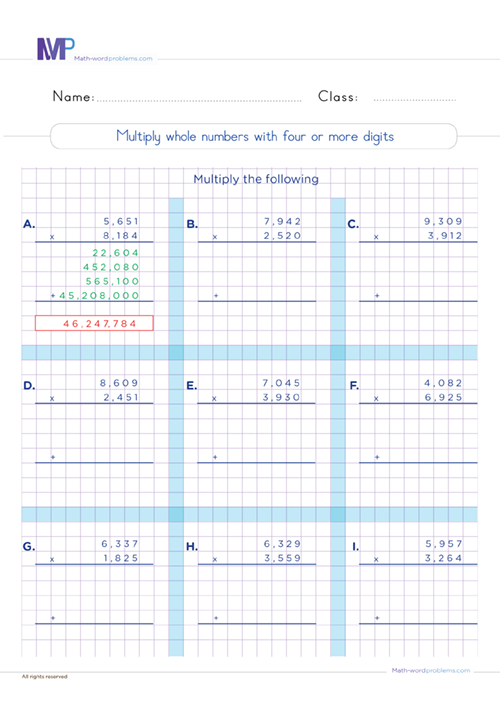 How do you multiply three or more numbers word problems?
How do you multiply three or more numbers word problems?
How do you multiply three or more numbers word problems? Most kids and even tutors want to know how to multiply larger digit numbers easily in word problems. You are just at the right place.
We have designed straightforward strategies and techniques that will enhance your multiplication problem-solving skills to a higher level. After going through our solving process, we will encourage 6th graders to give a detailed oral presentation from the first to the last step of solving. By so doing, they will greatly improve their working memory and mathematical skills.
Steps on how to solve multiplication of three or more numbers word problems
Below are outstanding and substantial steps on how to solve multiplication of three or more numbers word problems. These steps consist of very explicit instructions on how kids can tackle word problems no matter how challenging the problems may seem.
We also encourage kids to develop their mathematics vocabulary because it will help to master key terms that they’ll need when solving math word problems. Thus, gaining reading and reasoning skills at n early age is very important.
The following real-life example will guide your kids and show them how easy and fast these steps work.
Step 1: IDENTIFY
As you begin, read the whole problem carefully and identify important numbers and keywords in the word problem.
Now with this in mind, when you come across one of the following keywords in a word problem: - times, multiplied by, product, product of, factor, factor of, of, multiply, times, multiple, double, triple, groups, by, twice, area, equal groups, every, in all, total, increased by, as much, each, lots of, groups of, per, etc., then it implies that you have to perform a Multiplication Operation.
Note: One key Element for learners to understand is that they should not always rely on keywords alone. That is to say; the same keyword can have different meanings in different word problems.
For this reason, we reiterate on the importance of reading the question very carefully to understand the situation that the word problem is describing, then figure out exactly which operation to use
Step 2: STRATEGIZE
Think about how you will solve or go about solving the word problem.
- As you already know, from the keyword(s) in the word problem, you will know if you need to perform a multiplication Operation or Not.
- However, it would be best not to only count on keywords. Instead, try to understand the situation that the problem describes very well before diving into solving it.
- After knowing which operation you will perform, construct short expressions/sentences to represent the given word problem.
Step 3: SET UP
Subsequently, write down a numerical expression representing the information given in the word problem.
Step 4: PROVIDE A SOLUTION
From step 3 above, multiply the numbers using regrouping or other multiplication methods like long multiplication, grid multiplication, or lattice to determine the result. Also, always recall adding the unit of measurement to your answer, if any.
Step 5: CHECK YOUR WORK
On a final note, ask yourself this question. “Does my answer make sense?” If “YES,” you are done. If “NO,” go back to step 1 and start all over again.
Examples on how to solve multiplication of three or more numbers word problems
Example one
- How much money will she earn in a week?
- How much money will she earn in January?
- If her manager increases her pay to twice as before per hour, how much money will she make in 5 days?
Solution a
Step 1: First, the important numbers here are $17, 7 hours, and a week (7 days), and the keyword(s) found in the word problem is “per.”
Step 2: Next, how will you solve the problem? Clearly, the situation the problem is describing and the keyword found in the word problem call for you to perform a multiplication operation.
After knowing which operation you will perform, construct short expressions/sentences to represent the given word problem.
- Amount of money she earns per hour = $17.
- Number of hours she works per day = 7.
- Number of days in a week = 7.
- Therefore, the amount of money she earns in a week = the amount she earns per hour × Number of hours she works per day × the number of days in a week.
Step 3: Now, write down a numerical expression to represent the bolded sentence in step 2 above:
$17 × 7 × 7 = ?
Step 4: Then, multiply the numbers using regrouping or other multiplication methods like long multiplication, grid multiplication, or lattice to determine the result. Furthermore, always remember to add the unit of measurement to your answer, if any.
$17 × 7 × 7 = $833
So, she will earn $833 in a week.
Step 5: Finally, check out your work, i.e., if the answer makes sense by estimating the numbers and calculating mentally. If the answer is so close to the one you have, then your answer is correct but if the answer is not close to your answer, go back to step 1.
Solution b
Step 1: As you can see after reading the problem carefully, the important numbers here are $17, 7 hours, and January (31 days). Also, the keyword(s) found in the word problem is “per.”
Step 2: Next, how will you solve the problem? As seen from the problem described and the keyword, you need to perform a multiplication operation.
Now, after knowing which operation you will perform, Construct short expressions/sentences to represent the given word problem.
- Amount of money she earns per hour = $17.
- Number of hours she works per day = 7.
- Number of days in January = 31.
- Therefore, the Amount of money she earns in January = the amount she earns per hour × the Number of hours she works per day × the Number of days in January.
Step 3: Then, write down a numerical expression to represent the bolded sentence in step 2 above:
$17 × 31 × 7 = ?
Step 4: After that, multiply the numbers using regrouping or any other multiplication methods like long multiplication, grid multiplication, and lattice method to determine the result. Also, always recall adding the unit of measurement to your answer, if any.
Solve using regrouping
$17 × 31 × 7 = $17 × 7 × 31 = $3,689
So, she will earn $3,689 in January.
Step 5: Finally, check out your work, i.e., if the answer makes sense by estimating the numbers and calculating mentally. If the answer is so close to the one you have, then your answer is correct but if the answer is not close to your answer, go back to step 1.
Solution c
Step 1: As you can see after reading the problem carefully, the important numbers here are $17, 7 hours, and January (31 days). Also, the keyword(s) found in the word problem is “per.”
Step 2: Now, how will you solve the problem? At this point, the situation that the problem is describing and the keyword(s) found in the word problem call for multiplication operation.
After this, Construct short expressions/sentences to represent the given word problem.
- Amount of money she earns per hour = $17.
- Amount of money that was increased per hour= twice as before per hour.
- Amount of money she earns now per hour = Amount of money she earns per hour × Amount of money that was increased per hour = $17 × 2
- Number of hours she works per day = 7.
- Number of days given = 5.
- Therefore, the Amount of money she will earn in 5 days = the amount she earns now per hour × the Number of hours she works per day × the Number of days given.
Step 3: Now, write down a numerical expression to represent the bolded sentence in step 2 above:
$17 × 2 × 7 × 5 = ?
Step 4: Following this, multiply the numbers using regrouping or any other multiplication methods like long multiplication, grid multiplication, and lattice method to determine the result. Do not forget the sign, if any.
Solve by regrouping
$17 × 2 × 7 × 5 = $17 × 7 × 2 × 5 = $17 × 7 × 10 = $119 × 10 = $1,190
So, she will earn $1,190 in 5 days.
Step 5: Finally, check out your work to know if your answer makes sense i.e., by estimating the numbers and calculating mentally. If the answer is so close to the one you have, then your answer is correct but if the answer is not close to your answer, go back to step 1.
Example two
Step 1: After reading and digesting the problem very well, you see that this particular problem requires deep reading comprehension skills and conversation of text to numbers. So, you have to take your time and understand the problem first.
Also, the keyword(s) you will find in the word problem as you read further is “per” and “altogether”.
Step 2: Next, how will you solve the problem? Clearly, the situation the problem is describing and the keyword “per” found in the word problem call for you to perform a multiplication operation.
** Note that the keyword “altogether” here does not necessarily mean that you will perform an addition operation. It is for this reason we mentioned above that you must not rely only on keywords to determine the mathematical operation you need to use. **
After knowing which operation you will perform, Construct short expressions/sentences to represent the given relevant information in the word problem.
- Number of miles he cycles per hour = 6.
- Number of years given = 2.
- Number of days in a year = 365.
- Number of hours in a day = 24.
- Therefore, the number of miles he will cover for the 2 years = the Number of miles he cycles per hour × the Number of years given × the Number of days in a year × the Number of hours in a day.
Step 3: Now, write down a numerical expression to represent the bolded sentence in step 2 above:
365 × 24 × 6 × 2 = ?
Step 4: Then, multiply the numbers using regrouping or other multiplication methods like long multiplication, grid multiplication, or lattice to determine the result. Furthermore, always remember to add the unit of measurement to your answer, if any.
365 × 24 × 6 × 2 = 105,120
So, he will cover 105,120 miles for the 2 years.
Step 5: Finally, check out your work to know if your answer makes sense i.e., by estimating the numbers and calculating mentally. If the answer is so close to the one you have, then your answer is correct but if the answer is not close to your answer, go back to step 1.






